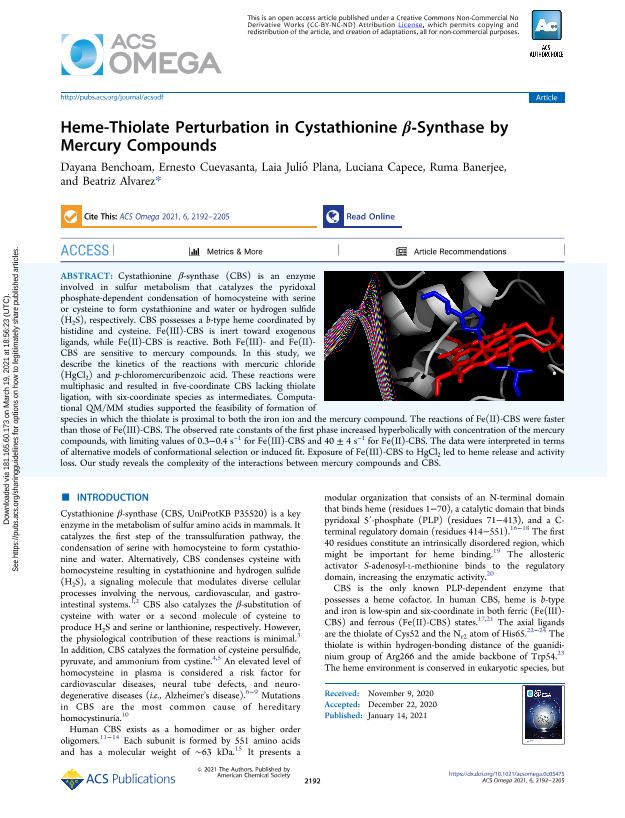Artículo
Heme-Thiolate Perturbation in Cystathionine β-Synthase by Mercury Compounds
Benchoam, Dayana; Cuevasanta, Ernesto; Julió Plana, Laia ; Capece, Luciana
; Capece, Luciana ; Banerjee, Ruma; Alvarez, Beatriz
; Banerjee, Ruma; Alvarez, Beatriz
 ; Capece, Luciana
; Capece, Luciana ; Banerjee, Ruma; Alvarez, Beatriz
; Banerjee, Ruma; Alvarez, Beatriz
Fecha de publicación:
01/2021
Editorial:
American Chemical Society
Revista:
ACS Omega
ISSN:
2470-1343
Idioma:
Inglés
Tipo de recurso:
Artículo publicado
Clasificación temática:
Resumen
Cystathionine β-synthase (CBS) is an enzyme involved in sulfur metabolism that catalyzes the pyridoxal phosphate-dependent condensation of homocysteine with serine or cysteine to form cystathionine and water or hydrogen sulfide (H2S), respectively. CBS possesses a b-type heme coordinated by histidine and cysteine. Fe(III)-CBS is inert toward exogenous ligands, while Fe(II)-CBS is reactive. Both Fe(III)-and Fe(II)-CBS are sensitive to mercury compounds. In this study, we describe the kinetics of the reactions with mercuric chloride (HgCl2) and p-chloromercuribenzoic acid. These reactions were multiphasic and resulted in five-coordinate CBS lacking thiolate ligation, with six-coordinate species as intermediates. Computational QM/MM studies supported the feasibility of formation of species in which the thiolate is proximal to both the iron ion and the mercury compound. The reactions of Fe(II)-CBS were faster than those of Fe(III)-CBS. The observed rate constants of the first phase increased hyperbolically with concentration of the mercury compounds, with limiting values of 0.3-0.4 s-1 for Fe(III)-CBS and 40 ± 4 s-1 for Fe(II)-CBS. The data were interpreted in terms of alternative models of conformational selection or induced fit. Exposure of Fe(III)-CBS to HgCl2 led to heme release and activity loss. Our study reveals the complexity of the interactions between mercury compounds and CBS.
Palabras clave:
Cystathionine β‐Synthase
,
Mercury Compounds
,
Heme-Thiolate
Archivos asociados
Licencia
Identificadores
Colecciones
Articulos(INQUIMAE)
Articulos de INST.D/QUIM FIS D/L MATERIALES MEDIOAMB Y ENERGIA
Articulos de INST.D/QUIM FIS D/L MATERIALES MEDIOAMB Y ENERGIA
Citación
Benchoam, Dayana; Cuevasanta, Ernesto; Julió Plana, Laia; Capece, Luciana; Banerjee, Ruma; et al.; Heme-Thiolate Perturbation in Cystathionine β-Synthase by Mercury Compounds; American Chemical Society; ACS Omega; 6; 3; 1-2021; 2192-2205
Compartir
Altmétricas



